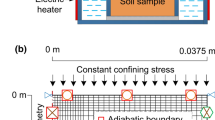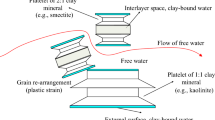Abstract
A fully coupled formulation combining reactive transport and an existing thermo-hydro-mechanical (THM) code is presented. Special attention has been given to phenomena likely to be encountered in clay barriers used as part of containment systems of nuclear waste. The types of processes considered include hydrolysis, complex formation, oxidation/reduction reactions, acid/base reactions, precipitation/dissolution of minerals and cation exchange. Both kinetically-controlled and equilibrium-controlled reactions have been incorporated. The total analytical concentrations (including precipitated minerals) are adopted as basic transport variables and chemical equilibrium is achieved by minimizing Gibbs Free Energy. The formulation has been incorporated in a general purpose computer code capable of performing numerical analysis of engineering problems. A validation exercise concerning a laboratory experiment involving the heating and hydration of an expansive compacted clay is described.
Similar content being viewed by others
References
Alonso E. E., Gens A. and Josa A. (1990). A constitutive model for partially saturated soils. Géotechnique 40: 405–430
Anderson G. and Crerar D. (1993). Thermodynamics in Geochemistry – The Equilibrium Model. Oxford University Press, New York, 588
Appelo C. and Postma D. (1993). Geochemistry Groundwater and Pollution. Balkema, Rotterdam, 536
Bear J. (1972) Dynamics of Fluids in Porous Media. Dover, 164 pp.
Bethke, C. M.: 1996, Geochemical Reaction Modeling. Oxford University Press, 397 pp. ISBN 0-19-509475-1
Cheng H. and Yeh G. (1998). Development and demonstrative application of a 3-D numerical model of subsurface, flow, heat transfer and reactive chemical transport: 3DHYDROGEOCHEM. J. Contam. Hydrol. 34: 47–83
Cuevas J., Villar M. V., Fernández A. M., Gómez P. and Martín P. L. (1996). Pore waters extracted from compacted bentonite subjected to simultaneous heating and hydration. Appl. Geochem. 12: 473–481
Custodio, E., Llamas, M. R.: 1983, Hidrogeología Subterránea, Ed. Omega, Barcelona, ISBN 84-282-0446-2, 2 volúmenes.
FEBEX, 1997, Caracterización geoquímica de bentonita compactada: efectos producidos por flujo termohidráulico. Report 70-IMA-M-0-2. CIEMAT. Madrid, Spain.
FEBEX, 1999, Termo-Hydro-Geochemical Tests on Small Cells. Report 70-IMA-M-0-5. . Madrid, Spain.
FEBEX, 2000, Full-scale engineered barriers experiment for a deep geological repository for high level radioactive waste in crystalline host rock. Final Report. Publicación técnica 1/2000 de la Empresa Nacional de Residuos Radiactivos (ENRESA). Spain.
FEBEX, 2001, FEBEX II. Informe sobre los resultados de la modelización THM. Informe 70-UPC-L-5-010. UPC-DIT. Barcelona, Spain.
Fernández, A. M.: 2004. Caracterización y Modelización del agua intersticial de materiales arcillosos: Estudio de la bentonita de Cortijo de Archidona. Ph.D. Thesis. Universidad Autónoma de Madrid, Spain, 505 pp. Editorial CIEMAT.
Fernández, A. M., Rivas, P.: 1999, Personal communication.
Friedly J. C. and Rubin J. (1992). Solute transport with multiple equilibrium-controlled or kinetically-controlled chemical reactions. Water Resour. Res. 28: 1935–1953
Gawin D., Baggio P. and Schrefler B. A. (1995). Coupled heat, water and gas flow in deformable porous media. Int. J. Num. Meth. Fluids 20: 967–987
Gens, A.: 1995, Constitutive Laws, in: A. Gens, P. Jouanna, B. A. Schrefler (eds.), Modern Issues in Non-saturated Soils. Springer–Verlag, pp. 129–158
Gens A., García-Molina A., Alonso E. E. and Huertas F. (1998). Analysis of a full-scale in situ test simulating repository conditions. Int. J. Numer. Anal. Methods Geomech. 22: 515–548
Gens A., Guimarães L. do N., García-Molina A. and Alonso E. E. (2002). Factors controlling rock-clay buffer interaction in a radioactive waste repository. Eng. Geol. 64: 297–308
van Genuchten R (1980) A closed-form equation for predicting the hydraulic conductivity of unsaturated soils. Soil Sci. Soc. Am. J. 892–898
Greenberg P. and Mφller N. (1989). The prediction of mineral solubilities in natural waters: the Na-K-Ca-Cl-SO4-H2O system to high concentration from 0 to 250 °C. Geochimica et Cosmochimica Acta 53: 2503–2518
Harvie C., Greenberg J. and Weare J. (1987). A chemical equilibrium algorithm for highly non-ideal multiphase systems: free energy minimization. Geochimica et Cosmochimica Acta 51: 1045–1057
Kirkner D. and Reeves H. (1988). Multicomponent mass transport with homogeneous, heterogeneous chemical reactions: effect of the chemistry on the choice of numerical algorithm 1. Theory. Water Resour. Res. 24: 1719–1729
Leroy P. and Revil A. (2004). A triple-layer model of the surface electrochemical properties of clay minerals. J. Colloid Interface Sci. 270: 371–380
Lichtner P. (1985). Continuum model for simultaneous chemical reactions and mass transport in hydrothermal systems.. Geochimica et Cosmochimica Acta 49: 779–800
Martín M., Cuevas J. and Leguey S. (2000). Difusión of soluble saltas under a temperature gradient after the hydration of compacted bentonite. Appl. Clay Sci. 17: 55–70
Olivella S., Carrera J., Gens A. and Alonso E. E. (1994). Nonisothermal multiphase flow of brine and gas through saline media. Transport Porous Media 15: 271–293
Olivella, S.: 1995, Nonisothermal Multiphase Flow of Brine and Gas Through Saline Media. PhD thesis. Departamento de Ingeniería del Terreno, Universidad Politécnica de Barcelona, España.
Olivella S., Gens A., Carrera J. and Alonso E. E. (1996). Numerical formulation for a simulator (CODE_BRIGHT) for the coupled analysis of saline media. Eng. Comput. 13: 87–112
Reed M. (1982). Calculation of multicomponent chemical equilibria and reaction processes in systems involving minerals, gases and an aqueous phase. Geochimica et Cosmochimica Acta 46: 513–528
Rubin J. (1983). Transport of reacting solutes in porous media: Relation between mathematical nature of problem formulation and chemical nature of reactions. Water Resour. Res. 19: 1231–1252
Saaltink M., Ayora C. and Carrera J. (1998). A mathematical formulation for reactive transport that eliminates mineral concentrations. Water Resour. Res. 34: 1649–1656
Schrefler, B. A.: 1995, F. E. in environmental engineering: coupled thermo-hydro-mechanical processes in porous media including pollutant transport. 7th European Autumn School: Non linear modelling of geomaterials with the finite element method. Aussois, France.
Steefel C. and Lasaga A. (1994). A coupled model for transport of multiple chemical species and kinetic precipitation/dissolution reactions with application to reactive flow in single phase hydrothermal systems. Am. J. Sci. 294: 529–592
Steefel C. and McQuarrie K. (1996). Approaches to modelling of reactive transport in porous media. Rev. Mineral. 34: 83–129
Thomas H. R. and He Y. (1995). An analysis of coupled heat, moisture and air transfer in a deformable unsaturated soil. Géotechnique, 45: 667–689
Thomas H. R., Cleall P. J. and Hashm A. A. (2001). Thermal/hydraulic/chemical/mechanical (THCM) behaviour of partly saturated soil. In: (eds) Computer Methods and Advances on Geomechanics., pp 743–748. Balkema, Rotterdam
White T. (1995). Multiphase nonisothermal transport of systems of reacting chemicals. Water Resour. Res. 31: 1761–1772
Wolery, T. J.: 1992, EQ3NR, A Computer Program for Geochemical Aqueous Speciation-Solubility Calculations: Theoretical Manual, User’s Guide, and Related Documentation (Version 7.0). Publicación UCRL-MA-1010662 PT III de Lawrence Livermore National Laboratory (LLNL). USA.
Xu T., Samper J., Ayora C., Manzano M. and Custodio E. (1999). Modeling of non-isothermal multi-component reactive transport in field scale porous media flow systems. J. Hydrol. 214: 144–164
Yeh G. and Tripathi V. (1991). A model for simulating transport of reactive multispecies components: model development and demonstration. Water Resour. Res. 27: 3075–3094
Author information
Authors and Affiliations
Corresponding author
Rights and permissions
About this article
Cite this article
Guimarães, L.D.N., Gens, A. & Olivella, S. Coupled Thermo-Hydro-Mechanical and Chemical Analysis of Expansive Clay Subjected to Heating and Hydration. Transp Porous Med 66, 341–372 (2007). https://doi.org/10.1007/s11242-006-0014-z
Received:
Accepted:
Published:
Issue Date:
DOI: https://doi.org/10.1007/s11242-006-0014-z




